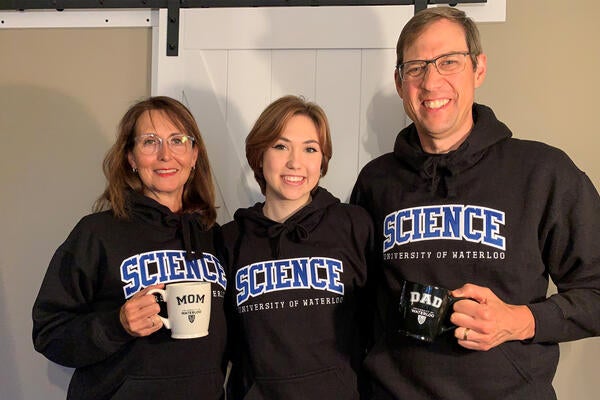
There’s something in the water in Waterloo … and beyond
Keeping tabs on our water resources in the face of climate change

Keeping tabs on our water resources in the face of climate change
By Sharon McFarlane Faculty of ScienceThis fall’s Convocation isn’t the first for Tim Shardlow who is graduating from a master's in biology (microbiology specialization). With a little luck and a lot of hard work, it won’t be his last either. The Erin, Ontario native has already started his PhD at the University of Waterloo in the same field of microbiology with an environmental focus, and is well on his way to unlocking hidden secrets of what’s in the water.
Shardlow found his academic passion in microbiology during his undergraduate years at Waterloo and since then has focussed his research ambitions to the study of bacteria in water. Under the guidance of Kirsten Müller, Chair of the Department of Biology, Shardlow studies cyanobacteria and the impact of climate change on water quality. “High rain levels saturate the ground which leads to soil run-off and an increase in nutrient deposits, and bacteria into the water,” he says, “This is obviously a concern for human health as this type of bacteria can produce toxins, including liver and neuro toxins, which are harmful if ingested. Our research helps guide water treatment plans to keep the population healthy.”
For his PhD research, Shardlow will focus on another consequence of climate change: forest wildfires. Specifically, he will study the impact caused by the 2016 devastating wildfire of Fort McMurray, Alberta on local water systems. According to Shardlow, the nutrients from dead tree matter are flushed into the water system, creating an ideal growth conditions for cyanobacteria to proliferate. His research has real world applications, and certainly real impact, on the communities whose water sources he studies.
Kirsten Müller couldn’t agree more. “Tim’s masters work on cyanobacteria in drinking water reservoirs has demonstrated that we need to be vigilant with our water resources in the face of climate change. I am very fortunate to have Tim as a graduate student in my research lab; he has been a leader among his peers through his undergraduate and graduate degrees here at the University of Waterloo.”
Shardlow feels very fortunate to be able to continue studying what he loves, at a university he has called home for over seven years. Besides academics, he has found satisfaction in activities that help his fellow students thrive at Waterloo by volunteering as an orientation leader, peer leader for the Living Learning Centre and mentor of Let’s Talk Science during his undergraduate years. During his graduate years Shardlow became a teaching assistant for microbiology and has continued his role as a science ambassador for the University- a role he has enjoyed since 2016.
When asked what he thought the world might think of science in a post pandemic world, Shardlow is full of optimism. “An increase in science literacy I believe is what the future of science is and needs to be. This doesn’t mean that I think everyone needs to pursue a science degree, but rather people should be encouraged to think like a scientist and incorporating that into their everyday lives. Learning how to ask questions, where to search for answers, understanding the facts and how they fit into the bigger picture are just some of the ways you can think like a scientist. Science should be seen not just as a discipline but as a mindset, allowing for a world full of people who can think critically, logically, and who are always curious to understand more.”

Read more
Star PhD graduates recount and reflect on their academic journeys

Read more
From lab partners to life partners, two science alumni welcome their daughter into the alumni club

Read more
Nominated by their peers, six exceptional students have inspired their colleagues with passion and resilience
The University of Waterloo acknowledges that much of our work takes place on the traditional territory of the Neutral, Anishinaabeg, and Haudenosaunee peoples. Our main campus is situated on the Haldimand Tract, the land granted to the Six Nations that includes six miles on each side of the Grand River. Our active work toward reconciliation takes place across our campuses through research, learning, teaching, and community building, and is co-ordinated within the Office of Indigenous Relations.